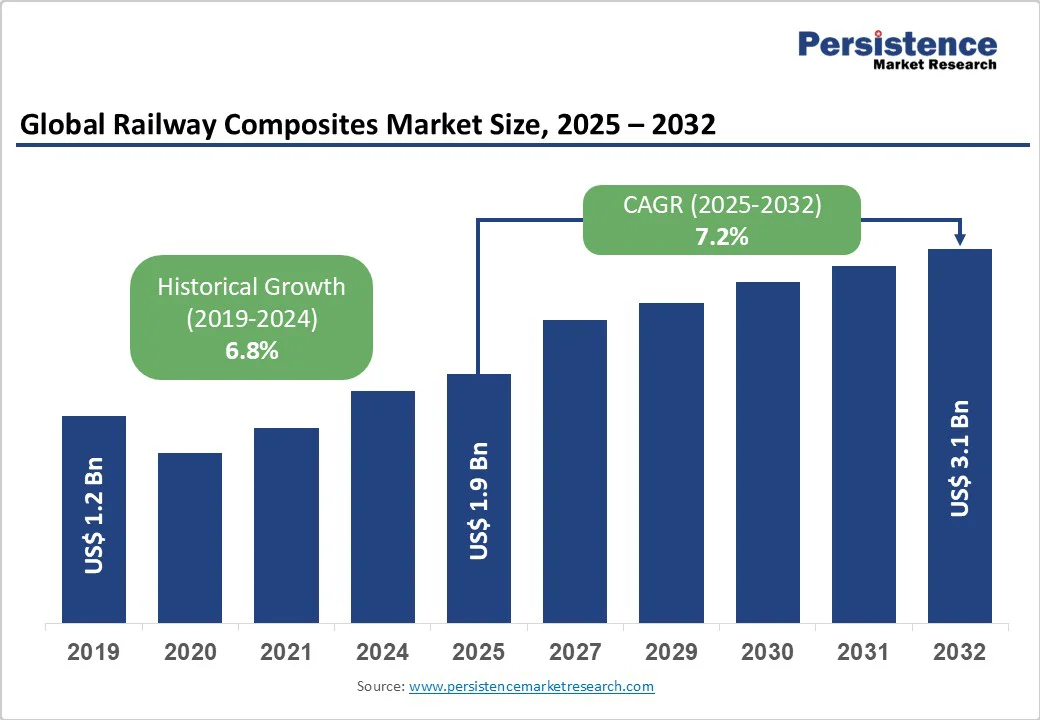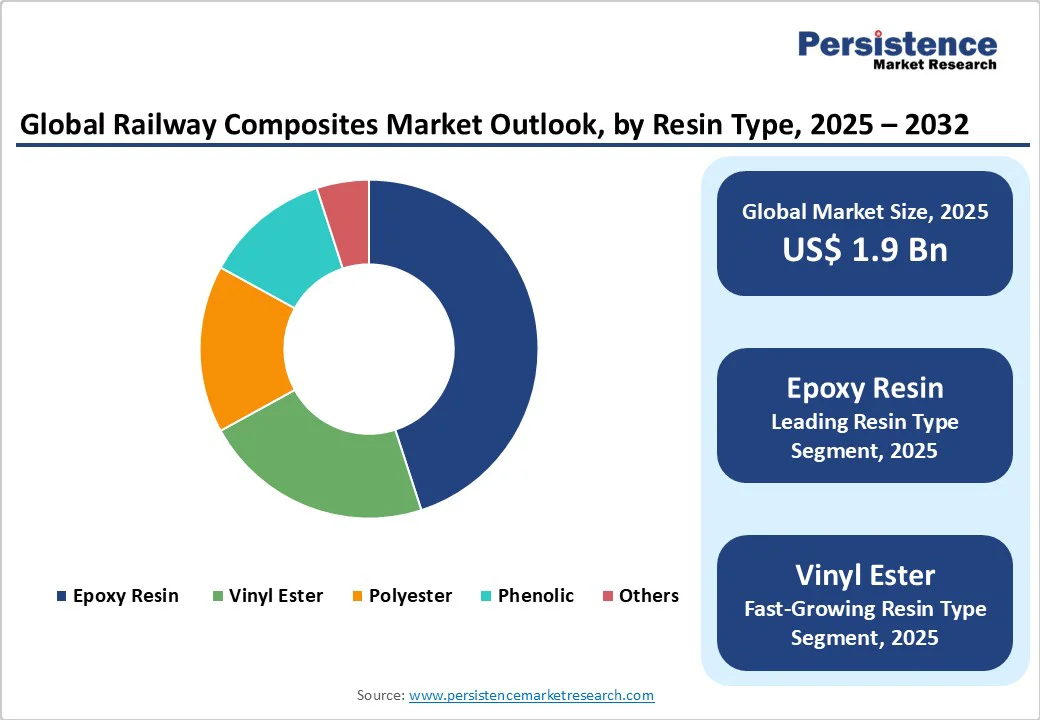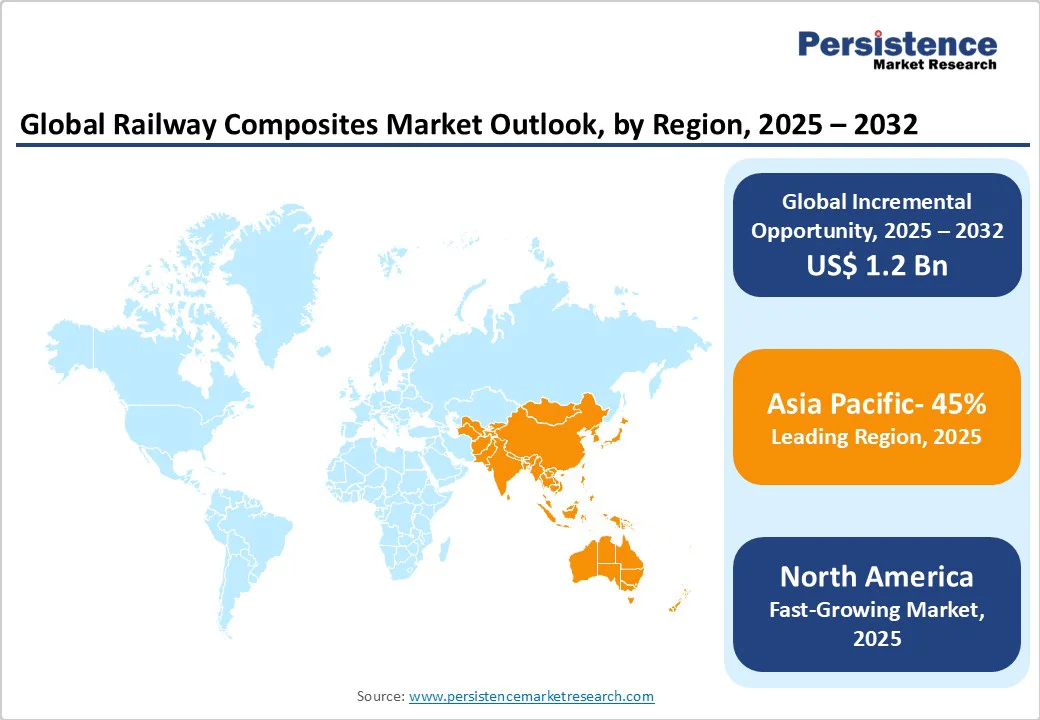ID: PMRREP11800| 187 Pages | 26 Sep 2025 | Format: PDF, Excel, PPT* | Automotive & Transportation

The global railway composites market size is likely to value at US$1.9 bn in 2025 and is expected to reach US$3.1 bn by 2032, growing at a CAGR of 7.2% during the forecast period from 2025 to 2032.
The increasing demand for lightweight, durable, and energy-efficient materials in modern rail systems. Expansion of high-speed networks, metro projects, and sustainable transportation initiatives drives the adoption of advanced composites and low-emission materials, enhancing fuel efficiency, reducing operational costs, and supporting regulatory compliance.
| Key Insights | Details |
|---|---|
| Railway Composites Market Size (2025E) | US$1.9 Bn |
| Market Value Forecast (2032F) | US$3.1 Bn |
| Projected Growth (CAGR 2025 to 2032) | 7.2% |
| Historical Market Growth (CAGR 2019 to 2024) | 6.8% |

The rising demand for lightweight materials is a significant driver in the railway composites market, particularly within high-speed rail networks. As modern trains operate at speeds exceeding 250 km/h, reducing weight is critical for improving energy efficiency, minimizing aerodynamic drag, and lowering maintenance costs on tracks.
Advanced composites such as carbon fiber-reinforced polymers (CFRP) and glass fiber composites are being adopted as alternatives to steel and aluminum due to their superior strength-to-weight ratios, corrosion resistance, and long service life. Their use not only enhances acceleration and braking performance but also supports sustainability initiatives by reducing overall energy consumption and carbon emissions.
Governments are actively promoting this transition through rail modernization projects that prioritize efficiency and sustainability. For instance, India’s Vande Bharat Express incorporates lightweight materials in its design to achieve faster travel and energy savings, while China’s high-speed rail program emphasizes the use of composites in car bodies and interiors to meet performance and policy targets.
High production costs remain a major restraint in the railway composites market. Advanced composites like carbon fiber and glass fiber-reinforced polymers require complex manufacturing processes, specialized equipment, and skilled labor, which significantly increase overall expenses compared to conventional metals. Additionally, raw material costs are volatile, further challenging large-scale adoption. These factors limit widespread use, particularly in cost-sensitive markets where operators prioritize affordability over long-term performance benefits.
Standardization issues add another layer of complexity, as the railway industry demands strict compliance with safety, durability, and interoperability standards. Variations in testing protocols and material specifications across regions hinder mass adoption and create barriers for manufacturers. The absence of universally accepted guidelines slows down approvals, increases development timelines, and restricts the pace of innovation.
The expansion of sustainable rail infrastructure is creating strong growth opportunities for the railway composites market. Governments and operators are increasingly focusing on eco-friendly solutions to reduce emissions, improve energy efficiency, and meet long-term climate goals.
Lightweight composites support these objectives by reducing energy consumption, lowering lifecycle maintenance costs, and enabling recyclable design options. Their integration aligns with global investments in green mobility and sustainable transportation networks.
Emerging markets further strengthen this opportunity, as rapid urbanization and rising demand for efficient mass transit accelerate investment in modern rail systems. Countries across Asia-Pacific, Latin America, and the Middle East are channeling resources into new high-speed rail projects, metro expansions, and cross-border corridors, offering significant potential for composite material adoption.
Epoxy resin is projected to dominate the railway composites market in 2025 with a 45% share, owing to its superior mechanical properties, excellent adhesion, and resistance to environmental stress. Its high durability and ability to withstand heavy loads make it the preferred choice for structural components such as train car bodies, interior panels, and flooring systems. The extensive use of epoxy in high-speed and heavy-haul rail applications highlights its role in ensuring long service life and safety compliance.
Vinyl ester, on the other hand, is emerging as the fastest-growing resin type, driven by its balance of strength, cost-efficiency, and chemical resistance. Its lower processing costs and versatility make it attractive for secondary structural parts and interior applications. Growing demand for lightweight and cost-effective solutions in emerging markets is expected to accelerate vinyl ester adoption across rail infrastructure projects.
Glass fiber is expected to dominate the railway composites market in 2025 with a 50% share, owing to its cost-effectiveness, versatility, and excellent mechanical performance. Its high strength-to-weight ratio, corrosion resistance, and thermal stability make it widely used in train interiors, exterior panels, and flooring systems. The affordability of glass fiber compared to other advanced materials ensures large-scale adoption, particularly in passenger and freight rail projects where balancing performance with budget constraints is essential.
Carbon fiber, meanwhile, is emerging as the fastest-growing segment due to its exceptional strength, stiffness, and lightweight properties. Although more expensive, carbon fiber offers significant energy savings and performance advantages in high-speed rail and advanced rolling stock applications. Its growing use in car bodies and structural components highlights its potential to transform next-generation railway systems focused on speed, efficiency, and sustainability.
The interior segment is projected to dominate the railway composites market in 2025 with a 40% share, driven by the rising demand for lightweight, durable, and fire-resistant materials. Composites are widely used in seating systems, panels, flooring, and luggage racks due to their ability to enhance passenger comfort while ensuring compliance with strict safety and fire-retardant regulations. Their versatility allows manufacturers to design ergonomic and aesthetic interiors without compromising strength or efficiency, making them the preferred choice for both high-speed and metro rail systems.
The exterior segment is anticipated to be the fastest-growing, supported by the need for aerodynamic designs and improved energy efficiency. Composite materials offer excellent weather resistance, corrosion protection, and reduced maintenance costs for exterior structures such as train car bodies, doors, and roofs. As rail operators increasingly invest in modernizing fleets and expanding high-speed networks, the adoption of composites in exterior applications is set to accelerate rapidly.

North America is expected to emerge as the fastest-growing region in the railway composites market, supported by increasing investments in modern rail infrastructure and sustainable mobility solutions. The United States and Canada are focusing on expanding high-speed rail networks and upgrading passenger transit systems to improve connectivity and reduce carbon emissions.
Government initiatives promoting lightweight, energy-efficient technologies are driving the adoption of composites in both new projects and the refurbishment of existing fleets. Additionally, rising emphasis on durable, low-maintenance materials for interiors and exteriors aligns with the region’s shift toward sustainable transportation, positioning North America as a key growth hub through 2025.
Europe is projected to account for a significant share in 2025, supported by its well-established rail infrastructure and strong focus on sustainable mobility. Countries such as France, Germany, and Spain are leaders in high-speed rail adoption, where lightweight and durable composites are increasingly preferred for both interiors and exteriors.
Strict EU regulations on emissions and safety standards further accelerate the use of advanced materials to improve energy efficiency, reduce lifecycle costs, and enhance passenger comfort. Additionally, ongoing investments in cross-border rail connectivity and modernization of rolling stock position Europe as one of the most influential regions in global growth.
Asia Pacific is set to dominate in 2025 with a 45% share, driven by rapid urbanization, expanding population, and large-scale investments in modern rail infrastructure. Countries such as China, Japan, and India are leading in high-speed rail development, metro expansions, and cross-border connectivity projects, creating strong demand for advanced materials.
Lightweight composites are widely adopted in this region to improve fuel efficiency, reduce operational costs, and meet sustainability goals. Supportive government initiatives, coupled with rising passenger traffic and the need for energy-efficient transportation, reinforce Asia Pacific’s leadership position and ensure continued dominance in the global railway sector.

The global railway composites market is characterized by continuous innovation, with companies focusing on developing lightweight, durable, and cost-efficient composite solutions tailored to modern rail requirements. Efforts are directed toward improving performance, reducing environmental impact, and complying with stringent safety and emission standards.
Strategic collaborations, research investments, and expansion into emerging markets are shaping the industry’s growth. Additionally, emphasis on recyclable and sustainable materials is becoming a key differentiator, as operators seek advanced solutions to support next-generation rail infrastructure worldwide.
The railway composites market is projected to reach US$1.9 Bn in 2025, driven by high-speed rail expansion and lightweight material demand.
Growing high-speed rail networks, sustainability initiatives, and passenger safety requirements fuels market growth.
The railway composites market will grow from US$1.9 bn in 2025 to US$3.1 bn by 2032, with a CAGR of 7.2%.
Sustainable infrastructure projects and emerging markets such as Asia Pacific drive opportunities for advanced composites.
Leading players include Avient Corporation, BASF SE, Celanese Corporation, Exel Composites, Hexcel Corporation, Kineco Limited, Mitsubishi Chemical Advanced Materials, Reliance Industries Limited, and Toray Industries Inc..
| Report Attribute | Details |
|---|---|
| Historical Data/Actuals | 2019 - 2024 |
| Forecast Period | 2025 - 2032 |
| Market Analysis | Value: US$ Bn, Volume: As Applicable |
| Geographical Coverage |
|
| Segmental Coverage |
|
| Competitive Analysis |
|
| Report Highlights |
|
By Resin Type
By Fiber
By Application
By Region
Delivery Timelines
For more information on this report and its delivery timelines please get in touch with our sales team.
About Author